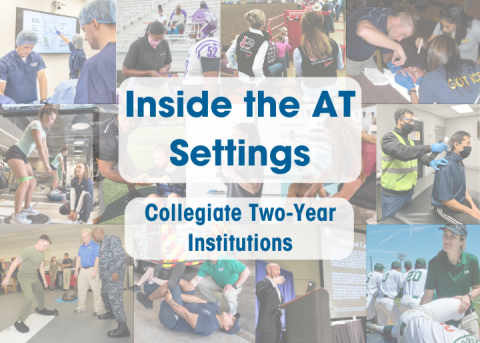
Editor’s note: This column kicks off a series of mental health-related columns that will be posted on the NATA Now blog throughout May in honor of Mental Health Awareness Month.
By Timothy Neal, MS, ATC, LAT
Assistant Professor/Clinical Education Coordinator
Concordia University Ann Arbor
The pressure of being a successful athlete entails non-stop activity of games, practice and physical conditioning.
Games and practice have traditional and non-traditional seasons, usually encompassing six or more months of the year. For many athletes, summers are spent on campus working out or practicing. Conditioning sessions that are physically taxing can take place as early as 5 a.m. to accommodate class or work schedules. Additional “voluntary” sessions of physical conditioning, film study, or skill development, along with the rigors of school work, the modern athlete is on “overload” as a result of participation demands from the moment they step on campus until they leave school. This can create, for the athlete, a condition of chronic stress physically and, more importantly, mentally.
The attitude of “more is better” in terms of constant activity in a quest for individual or team success is prevalent in today’s sports world, starting at the youth level and continuing through the secondary school and collegiate levels. Interestingly, professional sports have in place, through their collective bargaining agreements, mandated time off for the athletes to recover from the rigors of their season.
Burnout is a response to chronic stress of continued demands in a sport or activity without the opportunity for physical and mental rest and recovery. Burnout is a syndrome of continual training and sport attention stress, resulting in staleness, overtraining and eventually burnout. Many athletes experiencing burnout report feeling trapped by circumstances of sports participation. The athlete first starts feels stale or overwhelmed, but is encouraged by coaches, strength staff, athletic trainers, teammates or parents to push through symptoms of overtraining and potential burnout to continue with a demanding schedule in order to feel a part of the team, maintain their starting position or keep their scholarship.
Other athletes self-induce their burnout with personal motivation for success. This type of athlete applies more personal demands on their physical conditioning and skill sessions, or is fully consumed by sports participation as a way to fulfill their identity as an athlete. Either way, the chronic stress the athlete experiences without the opportunity to rest and recover from the rigors of such stress places the athlete at risk for burnout. For some athletes, burnout may be the triggering mechanism in developing or exacerbating a mental health disorder that negatively impacts the athlete’s life and relationships.
Burnout affects the athlete in various stages:
- The athlete is placed in a situation that involves new or varying demands on their physical ability and time management
- The athlete at some point – usually early on as a young athlete, or later if a more experienced athlete – views the demands as excessive or non-productive
- The athlete feels as if their performance is being hampered by the demands of participation and the inability to rest and recover
- The athlete starts experiencing subtle signs and symptoms of physical and mental burnout
- Burnout takes place and the physical and mental toll on the athlete impacts their lives and performance on and off the field, perhaps even discontinuing sports participation
Signs and symptoms of burnout include:
- Leveling off or diminished performance or conditioning, including strength and stamina losses, chronic fatigue
- Physiological signs such as having a higher resting heart rate and blood pressure
- Cognitive issues such as difficulty in concentration or diminished work in school, forgetfulness
- Illnesses as a result of suppressed immune system
- Emotional issues such as disinterest, moodiness, irritability
- Low self-esteem, increased anxiety and depression as a result of falling short of sport demands
Athletic trainers can help in identifying and preventing burnout in athletes through an awareness of the signs and symptoms, and in communication with coaches and strength staff to monitor the athletes for overtraining, which is a large contributor of burnout. Whenever an athlete, particularly a younger athlete new to the level of participation, exhibits some signs and symptoms of burnout, a physician evaluation for a physical cause is warranted. After the physician exam and any testing prove negative, consideration should be given to modifying the activity to permit more athlete rest and recovery. If physical causes for signs and symptoms of burnout are negative, consideration should be given to referring the athlete for a psychological evaluation and care.
Coaches and strength staff should be educated on burnout and consider modifications to workouts both in terms of intensity and length of time in order to preserve optimal levels of performance and to prevent burnout. Some measures such as heart-rate monitoring during practice and conditioning are one of several approaches teams are utilizing to monitor potential overtraining.
Rest and time away from sport are the two best methods to prevent and treat athlete burnout. Athletes, like most students and American adults, do not get enough sleep to feel rested and ready for physical and mental activity throughout the day. Seven to eight hours of sleep are recommended daily. Considering that many athletes rise before or at dawn for conditioning sessions and practice, their sleep cycle is hampered to be fully effective in providing the rest necessary for daily activities and optimal school and sports performance. This results in a state of constant fatigue, placing the athlete at risk for developing burnout and mental health issues, especially when the athlete feels there is no escaping the time and physical demands of their sport and school.
Time away from sport is another method of preventing burnout. Being away from the demands of their sport, even for a short period several times a year, provides an athlete with an opportunity to attend to their schoolwork and relationships that are necessary to leading a more rounded life that leads to enhanced motivation once they return to sport.
Burnout is a very real and underreported state that many athletes experience. Knowing the signs and symptoms of escalating burnout, along with an appreciation how burnout occurs, are important steps in prevention and treatment of this situation, and may well prevent the start or worsening of a mental health disorder in an athlete.
To help you educate parents, athletes, coaches and others about burnout, NATA has created a burnout and mental health handout (pdf), which was featured in the May NATA News.
Don’t forget to check out our other infographic handouts that have been made available for NATA members to download, reprint and distribute to their local communities.





